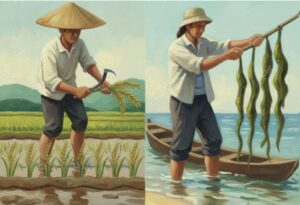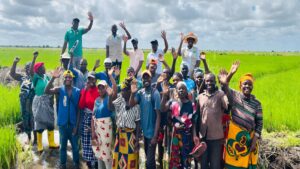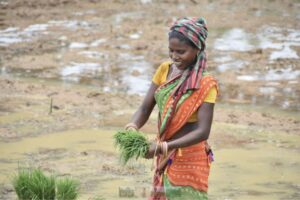Many countries have greatly benefited from the agricultural technology developed at IRRI with the support of traditional donors. In recent decades, India and the Philippines have transitioned from being solely research beneficiaries to partners by financing some of their own research activities at the Institute. This new kind of partnership, which IRRI wants to explore and grow with other nations, could fund the next-generation of rice science.
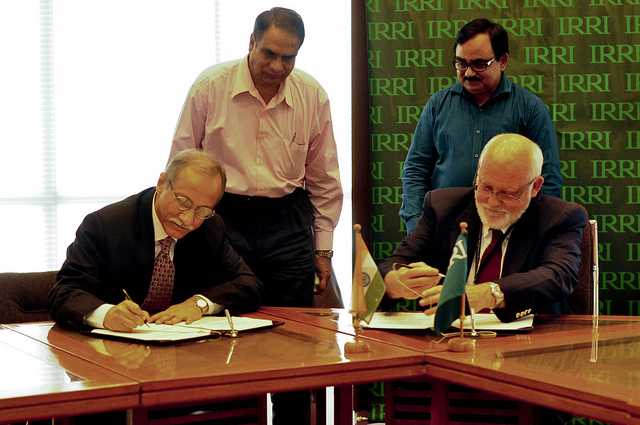
In March 2014, the Philippine Department of Agriculture launched a project to conserve heirloom rice of the Cordillera Region in Northern Luzon. The Heirloom Rice Project aims to shine the spotlight on obscure indigenous varieties in lucrative local and international premium food markets. By creating a demand for them, much like with basmati and jasmine rice, heirloom rice could sustain the region’s struggling upland farmers.
That the Philippines’ Department of Agriculture is collaborating with the International Rice Research Institute (IRRI) to provide the research backbone of this project is not new. However, something is fundamentally different about the Heirloom Rice Project. It is an example of a new partnership setup between IRRI and the Philippines in which traditional donor agencies do not provide the funds to carry out the activities.
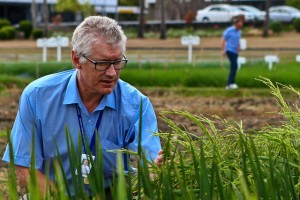
Powered by philanthropy
From its founding, IRRI has been sustained by the deep pockets and generosity of donor agencies. In December 1959, the Philippine government and the Ford and Rockefeller Foundations signed a memorandum of understanding in New York establishing “an organization to do basic research on the rice plant and applied research on all phases of rice production, management, distribution, and utilization.” It was essentially a declaration of war against starvation in Asia, where the production of rice—the staple for most of the continent—lagged dangerously behind its population growth.
Powered by philanthropy, the Institute developed some of the most potent weapons against hunger and poverty from its experimental fields in the Philippines. The Institute’s first director, Robert Chandler, put together a team of rice scientists to breed a new kind of rice that overcame the yield limits of all existing varieties. That variety is the famous IR8—a semidwarf rice known as “miracle rice” for its ability to produce twice the yield of traditional rice varieties and, in some places, setting unheard of yield ranging from 6 to 10 tons per hectare.
IR8 (and all the high-yielding rice varieties that came after it), the modern technologies, and the scientific advances that changed the course of rice production are all knowledge-based public goods available to every country, regionally or even globally, that needs them. Certainly, none of those would exist today without the funding provided by philanthropic foundations, international organizations, and governments of mostly Western countries.
In the past decades, however, the focus of the aid architecture on the development landscape has been gradually shifting from Western-centric to various emerging medium-sized and small development partners.
And, the development activities funded by emerging research investors known as “partner countries” are rapidly growing in importance.
“Traditionally, IRRI has worked with countries to conduct research and training on the basis of grants from various agencies or from the CGIAR fund,” said Matthew Morell, IRRI deputy director general for research. “But, increasingly, as countries become richer and have a higher technical base, they are coming to us to fund joint programs targeted to their specific interests. We have strong examples of projects like that in India and the Philippines.”
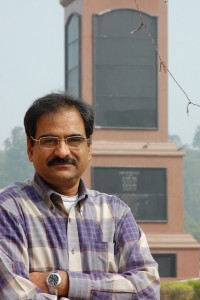
A new phase of partnership
One of the most spectacular cases of how donor investments in IRRI’s rice research have had an impact on a beneficiary country is India. India has come a long way from a country with a severe food deficit to being a major grain exporter, according to Samarendu Mohanty, head of the Social Sciences Division at IRRI.
“Indian rice and wheat production in the past five decades rose by more than three- and eightfold, respectively. During this period, per capita availability increased by more than 10 kilograms for rice and 50 kilograms for wheat,” Dr. Mohanty said. “The rise in grain production eventually transformed India from a grain importer to an exporter in the mid-1990s. Since then, grain exports (rice, wheat, and maize) have steadily increased, reaching 24 million tons by 2012-13. The transformation of the rice sector was even more startling, with India dethroning Thailand to become the largest exporter of rice in 2012.” (See India reaches the pinnacle in rice exports.)
The government of India has been funding some of IRRI’s research collaborations with the Indian Council of Agricultural Research (ICAR). It is the apex body for coordinating, guiding, and managing research and education in agriculture in the country. With 99 institutes and 53 state agricultural universities spread across the country, ICAR is one of the largest national agricultural research systems in the world. For more than 50 years, IRRI and ICAR have been partners in rice research activities focusing on outcomes to benefit farmers and consumers.
“IRRI-India collaboration has matured and so have the needs, expectations, and environment of doing business in relation to what is happening not only in India but also regionally and globally,” said Jagdish K. Ladha, IRRI scientist and country representative for India and Nepal. “India has a strong national rice research program with increasing participation by the private sector and civil society organizations.”
In 2013, under the ICAR-IRRI Work Plan 2013-16, the collaboration yielded several solid achievements: 12 rice varieties released as well as drought-, flood-, and salinity-tolerant rice lines developed and now used in several breeding programs.
The Philippines emerges
The Philippines has rice research and development collaboration projects under the Food Staples Sufficiency Program (FSSP) of the Philippine Department of Agriculture. The FSSP is the country’s strategy to achieve rice self-sufficiency by 2013 and maintain it through 2016. Aside from the Heirloom Rice Project, other FSSP activities in which IRRI plays a pivotal role are the Accelerating the Development and Adoption of Next-Generation Rice Varieties for the Major Ecosystems in the Philippines (NextGen) project and the Philippine Rice Information System (PRISM) project.
NextGen aims to accelerate the introduction and adoption of higher-yielding rice varieties and hybrids that can withstand flood, drought, and salinity in order to raise current yield in rice production (see Bouncing back from Typhoon Haiyan). PRISM is developing a monitoring and information system for rice production in the country.
The Philippine government is footing the bill for all these projects as the country has been assuming a greater partnership role with IRRI. “Countries like the Philippines are starting to invest in rice research for their own benefit. The Institute supports such a move,” said Bruce Tolentino, IRRI deputy director general for communication and partnerships. “We are now working with the Philippine Rice Research Institute, the University of the Philippines Los Baños, and the regional offices of the Department of Agriculture to bridge the gap between local rice production and consumption.”
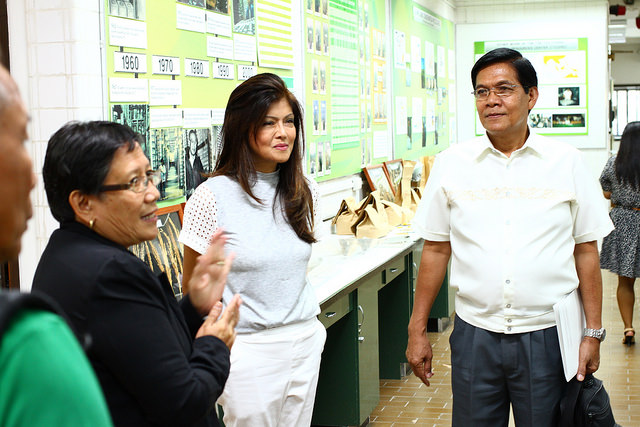
It is not only the national government collaborating with IRRI. In May 2015, Ilocos Norte Governor Imee Marcos visited IRRI to find viable interventions to climate-related challenges facing rice farmers in her province. Ilocos Norte, in the northern part of Luzon, has a total of 66,000 hectares of upland and irrigated rice areas and is one of the top rice producers in the country. In recent years, however, drought has affected more than a thousand hectares of rice fields.
“In the last four years, extreme drought has hit the province, causing significant production losses,” Gov. Marcos said. To address this concern, she has allocated funds for science-based agricultural interventions and solutions.
Under the FSSP, IRRI and its partners will work together to enhance Ilocos Norte’s rice production system to better cope with drought. IRRI will provide the provincial government with rice seeds tolerant of environmental stresses, which the regional agriculture office will distribute to drought-prone areas. The Philippine Rice Research Institute will provide training on dry seeding and advice on setting up water-harvesting stations.
Gov. Marcos also requested a blueprint of a mechanized seed driller developed at the Institute. The seed driller, designed by IRRI agronomist Yoichiro Kato and his team, provides farmers with an option to directly sow the seeds of rice and other crops in dry soil so that their fields are ready when the rains come. This eliminates the need to prepare nursery beds and transplant seedlings that simply wither and die when rains do not come. IRRI will provide training as well as the blueprint for its fabrication in the province.
“There is always a package, a set of interventions, that can improve farm productivity and farmers’ income. What is crucial is to focus available budgets on those actions that make a positive difference,” Dr. Tolentino said. “We hope to ensure that we’re able to put options on the table and you can make choices.”
The Philippines is even going beyond rice productivity. The National Food Authority (NFA) signed a memorandum of understanding with IRRI on improving rice quality in the Philippines. Under the agreement, signed in June 2015, the NFA and IRRI will promote and accelerate research on rice and rice-based farming systems toward establishing international standards for rice quality. Rice quality encompasses farming technologies and practices that help ensure sustainable agriculture, improved farmer welfare, higher grain quality, and dietary practices that support improved nutrition and health among consumers.
“Through this agreement, the NFA hopes to maximize IRRI’s research in achieving our food security mission of providing the country’s rice requirements in terms of volume and quality,” said NFA Administrator Renan Dalisay. “This will also guide us in our decision-making, not only in our operational activities but also in policy formulation, in anticipation of future developments such as infrastructure buildup.”
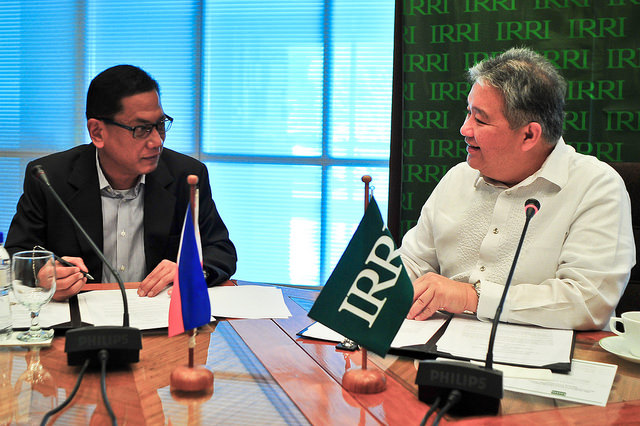
From beneficiaries to clients
The Philippines and India have been recipients of assistance programs since the beginning of IRRI. Judging from the success of the Green Revolution, both countries greatly benefited from the development aid provided by IRRI’s donors. Why institutionalize their aid efforts?
For one, they can decide on their own research agenda from their own perspective. They can pursue activities of their own national economic interest with no strings attached and interference built in the assistance policies of traditional donors.
Traditional donors are very focused on meeting the needs of particular disadvantaged groups within a country that might be facing a particularly difficult poverty or production environment, according to Dr. Morell. “But there are areas where a country might identify that it has a specific need,” he said. “It may have a particular area that it wants to focus on, which is not a donor priority. That might be the basis of the relationship with IRRI to provide research support. Countries have an opportunity to influence the research agenda so that IRRI does focus on research that is primarily important to them.
“It also means that, if the whole research is done in collaboration with a national partner, the research can be adapted and tailored to meet local requirements as quickly as possible,” he added.
Dr. Tolentino also sees a significant change in the dynamics of the partnership between an emerging research investor and IRRI. Funding and justification for the research become the responsibility of the collaborating government and institution so they can also set their own mutually agreed-upon accountability measures.
“By funding the research activities themselves, they shift from beneficiaries to clients,” he said. “Scientists now care more about the country-investor instead of satisfying the requirements of the traditional donors. It becomes a partnership of equals.”
Under the evolving partnership with India, Dr. Ladha described IRRI’s role as a facilitating international organization, not an organization that tries to take over the functions of the public or private sector.
“Our comparative advantage is in strong science and innovation, looking at the big picture, and training in the frontier areas,” he added. “But also in catalyzing technology transfer to farmers and others in the value chain.”
Compounding research interest
However, the funding needed for a country-level research agenda could easily run into several millions of dollars, seemingly beyond the reach of some of IRRI’s partner countries. Dr. Tolentino does not think this is a hindrance for countries to provide such significant amounts of funding, emphasizing that rice science has the nature of being a global public good.
“Partner countries can pool their resources and invest in IRRI,” he said. “IRRI has the expertise, the experience, the laboratories, and experiment stations—the critical mass to successfully undertake such research for the benefit not only of one country, but for all countries. Investment in IRRI is much more efficient than each country building its own laboratories and research systems with many scientists working in isolation. Global public goods, once developed and introduced, benefit all countries.”
Dr. Morell hopes that IRRI’s partner countries will appreciate the international influence that their funding has and that, by each contributing to this process, they will benefit from the investments that the others make. “It’s an important enabling relationship,” he said.
This enabling relationship is very true for India.
“IRRI in partnership with Indian institutions should play a major role in implementing an upstream research agenda that includes targeted breeding and systems agronomy research, and a training program in frontier areas,” Dr. Ladha said. “These will have a spillover benefit for other member countries of the South Asian Association for Regional Cooperation.” The South Asian Association for Regional Cooperation is an economic and geopolitical organization that involves Bangladesh, Bhutan, India, Maldives, Nepal, Pakistan, Sri Lanka, and Afghanistan.
“India, with its large diversity of soil and climate, provides unique opportunities to develop situation-specific rice varieties that will be relevant to not only India but also other neighboring countries such as Nepal,” continued Dr.Ladha. “In genomics and bioinformatics, for which Indian institutions have strong programs, India could play a key role in supplementing IRRI’s global agenda.” (See Rice diplomacy in South Asia.)
Engaging emerging research investors
Beyond the two countries, IRRI has embarked on a series of bilateral relationship strengthening exercises with ministries of agriculture and rice departments across Southeast and South Asia and Eastern and Southern Africa. To do this, IRRI appointed different scientists to serve as “country coordinators.”
“There will be no partnership if our research is not relevant to country needs,” said Dr. Tolentino. “Their role is to know the latest situation and developments in the rice sector in their assigned country. They have to make annual status reports, prepare a collaborative research agenda, assess results, and plan for the next steps. They have to engage the government.”
“This is really an important way to be well connected to the regions so that we understand their issues and problems; thus, we can provide the science and technology,” said Dr. Morell. “The test of the value of the collaboration and the relationship is when people are willing to sit down together and combine their attention and capacities to work on a focused set of questions. This is an important way of enhancing IRRI’s relationship with the regions and improving the ability of science to reach the maximum number of people who need that science across a region.”
With 16 partner countries, IRRI certainly has plenty of engaging to do. But Dr. Morell isn’t daunted by the tasks ahead.
“There are clearly important and significant differences between all of our partner countries and that’s part of the richness and excitement of working in rice,” he said. “IRRI is still very much respected as an honest broker in providing impartial advice. We hope that we have earned their trust from a very strong relationship and a long period of interaction. There is also recognition that we deliver what people are looking for.”
Although the overall spending of IRRI’s partner countries pales in comparison with that of traditional donors today, what are the expectations from them in the future? Will IRRI run solely on this type of funding?
“Traditional donors have continuing interest in a whole range of concerns in various countries and we certainly will be continuing to work with them,” said Dr. Morell. “But, as the national institutions in the countries that we are dealing with develop, we will continue the strong collaboration and engagement with them as they go on their journey. We think this is a very interesting and exciting way for partnerships to grow in the future.”
Mr. Santiaguel is an associate editor of Rice Today.


